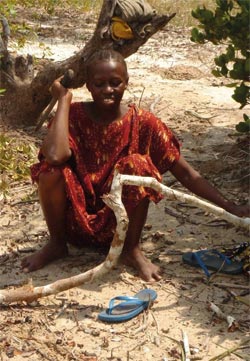We’ve helped protect over 100 hectares of tropical Kenyan mangrove forests by setting up a carbon credit scheme. Thousands of miles away, in Brazil, another scientific scheme is helping conserve mangrove crabs – a national delicacy and key to the country’s coastal ecosystem.
Protecting & Restoring Blue Carbon Ecosystems in Kenya
Empowering Kenya's coastal communities
 Thirty miles south of Mombassa, on the coast of Kenya, lies Gazi Bay, where Professor Mark Huxham is working with Dr James Kairo from the Kenya Marine and Fisheries Research Institute.
Thirty miles south of Mombassa, on the coast of Kenya, lies Gazi Bay, where Professor Mark Huxham is working with Dr James Kairo from the Kenya Marine and Fisheries Research Institute.
Their project, called Mikoka Pamoja, combines forest conservation with local development. It sells carbon credits generated through mangrove planting and restoration, raising about $12,000 a year for local reinvestment. This brings direct financial, social and educational benefit to local people.
More than 30% of the annual revenue generated will be channelled into a special fund to benefit local community projects. The rest will pay for a project coordinator and local labourers to help protect and re-plant mangroves along Gazi’s coastline.
Why mangroves matter
With roots adapted to filter salty water, mangroves grow in tropical and subtropical tidal areas, forming dense forests in the sediment of estuaries. Mangrove forests act like natural barriers, protecting coastal communities from storms and tsunamis. They’re also one of the most efficient natural carbon sinks, locking and storing CO2 at up to five times the rate of tropical rainforests.
“Mangrove wood is used for building material and fuel, because it’s a readily available material. But current rates of cutting are unsustainable, and when a forest is removed large quantities of carbon are released directly into the atmosphere – carbon that’s been stored in the soil for thousands of years,” said Professor Mark Huxham.
The walking trees
With their dense tangle of roots exposed above the water level like limbs, mangroves are sometimes known as ‘the walking trees’. They form an important habitat for thousands of kinds of fish, birds, crustaceans, insects and other marine life, providing food and places to live. Mangroves also act as nurseries for many fish – including species that spend most of their later lives out in the open sea.
Interested in this research? Contact Professor Huxham.
Influencing Legislation to Benefit Mangrove Crabs & Livelihoods in Brazil
Saving Brazilian mangrove crabs
In the tropics, mangrove forests that grow at the interface between land and sea form highly productive ecosystems that protect coastlines and support a rich fish and invertebrate fauna. In Brazil, caranguejo-uçá, a large intertidal mangrove crab, is a key species in this system, as it consumes most of the fallen leaves, thereby retaining energy and accelerating nutrient cycling. This crab is also a national delicacy, and there’s a lucrative market supplied by local crab fishermen.
 Professor Karen Diele of Edinburgh Napier has been leading projects studying the ecological role and the artisanal fishery of these crabs. Her research has been instrumental in improving fisheries legislation aimed at the sustainable use of this species, which is also a major interest to fishermen and the wider community.
Professor Karen Diele of Edinburgh Napier has been leading projects studying the ecological role and the artisanal fishery of these crabs. Her research has been instrumental in improving fisheries legislation aimed at the sustainable use of this species, which is also a major interest to fishermen and the wider community.
Working with Dr Anders Schmidt and other Brazilian collaborators, she has now established a North to South mass mate-searching monitoring network to help improve the temporal placement of crab capture bans.
“My research addresses many applied questions that are of direct interest to the local people. Working closely with fishermen and managers to deliver solutions has been a great experience,” said Prof Karen Diele.
Her work has also featured on a popular documentary series on Brazilian TV and on BBC Radio 4, taking the message beyond the immediate area of her study sites in Northern and Northeastern Brazil.
Interested in this research? Contact Professor Diele.